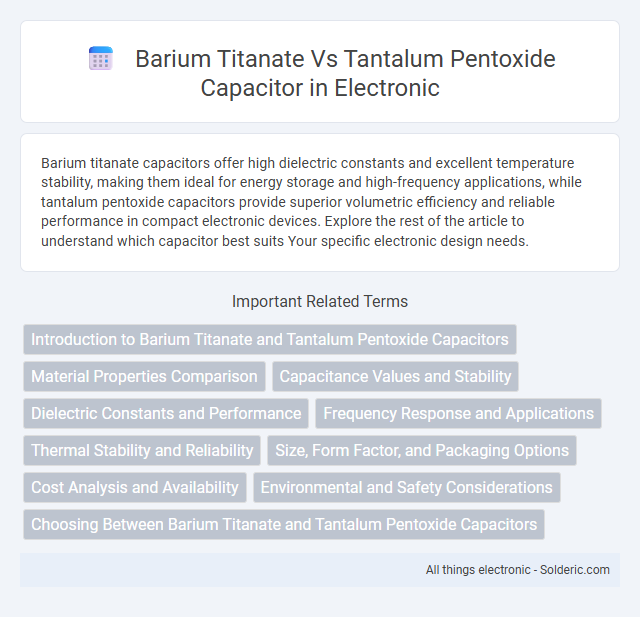Barium titanate capacitors offer high dielectric constants and excellent temperature stability, making them ideal for energy storage and high-frequency applications, while tantalum pentoxide capacitors provide superior volumetric efficiency and reliable performance in compact electronic devices. Explore the rest of the article to understand which capacitor best suits Your specific electronic design needs.
Comparison Table
| Feature | Barium Titanate Capacitor | Tantalum Pentoxide Capacitor |
|---|---|---|
| Dielectric Material | Barium titanate (BaTiO3) | Tantalum pentoxide (Ta2O5) |
| Capacitance Range | Low to moderate (pF to nF) | Moderate to high (mF range) |
| Voltage Rating | Low to medium (typically <100 V) | Medium to high (up to 50 V or higher) |
| Dielectric Constant (er) | High (~1000-3000) | Moderate (~25-30) |
| Temperature Stability | Poor to moderate | Good stability over temperature |
| Leakage Current | Higher leakage | Low leakage current |
| Applications | High-frequency filters, sensors | Power supply filtering, decoupling |
| Cost | Lower cost | Higher cost |
| Mechanical Stability | Fragile and sensitive to stress | Robust and reliable |
Introduction to Barium Titanate and Tantalum Pentoxide Capacitors
Barium titanate capacitors, known for their high dielectric constant and excellent temperature stability, are widely used in high-frequency and precision electronic circuits. Tantalum pentoxide capacitors offer superior volumetric efficiency and reliability, making them ideal for applications requiring stable capacitance and long service life. Understanding your specific requirements helps determine whether barium titanate's temperature resilience or tantalum pentoxide's performance under stress best suits your capacitor needs.
Material Properties Comparison
Barium titanate capacitors exhibit high dielectric constants and excellent temperature stability, making them ideal for applications requiring precise capacitance control. Tantalum pentoxide capacitors offer superior volumetric efficiency and better performance at high frequencies due to their stable oxide layer. Understanding these material properties helps you select the capacitor best suited for durability, capacitance range, and operational environment.
Capacitance Values and Stability
Barium titanate capacitors typically offer high capacitance values due to their high dielectric constant, making them suitable for applications requiring larger capacitance in smaller packages. Tantalum pentoxide capacitors provide lower capacitance but exhibit superior stability and reliability over a wide temperature range and voltage conditions. The capacitance stability of tantalum pentoxide capacitors ensures consistent performance in precision circuits, while barium titanate capacitors may experience variations due to temperature and aging effects.
Dielectric Constants and Performance
Barium titanate capacitors feature dielectric constants ranging from 1,000 to 10,000, significantly enhancing energy storage and enabling higher capacitance values in compact sizes. In contrast, tantalum pentoxide capacitors have lower dielectric constants, typically around 27, resulting in lower capacitance but superior stability and reliability under varying temperatures and voltages. Your choice depends on whether high capacitance density or stable performance under stress is the priority in your application.
Frequency Response and Applications
Barium titanate capacitors exhibit superior frequency response at high frequencies, making them ideal for RF and microwave applications due to their high dielectric constant and low dielectric loss. Tantalum pentoxide capacitors perform better in stable, low-frequency environments, commonly used in power supply filtering and decoupling where reliability and capacitance stability are critical. The frequency characteristics of barium titanate favor high-speed circuits, whereas tantalum pentoxide is preferred in energy storage and smoothing applications.
Thermal Stability and Reliability
Barium titanate capacitors exhibit superior dielectric constants but have limited thermal stability, making them more susceptible to performance degradation at elevated temperatures compared to tantalum pentoxide capacitors. Tantalum pentoxide capacitors offer enhanced thermal reliability due to their stable oxide layer, which maintains capacitance and low leakage currents under high-temperature conditions. For applications requiring long-term stability and consistent performance in harsh thermal environments, choosing tantalum pentoxide capacitors can ensure greater reliability and durability for your electronic circuits.
Size, Form Factor, and Packaging Options
Barium titanate capacitors often offer smaller sizes and more compact form factors due to their high dielectric constant, making them ideal for applications where space is limited. Tantalum pentoxide capacitors typically come in a variety of packaging options, including chip and radial styles, providing versatility in mounting and assembly processes. When selecting your capacitor, consider that tantalum capacitors generally support higher capacitance values in slightly larger packages compared to barium titanate counterparts.
Cost Analysis and Availability
Barium titanate capacitors generally offer lower production costs due to abundant raw materials and simpler manufacturing processes, making them more cost-effective for bulk applications. Tantalum pentoxide capacitors, while providing superior performance and stability, face higher costs linked to the scarcity of tantalum and complex refinement techniques. Availability of barium titanate capacitors is typically higher, with widespread suppliers and consistent material supply, whereas tantalum pentoxide capacitors may experience supply chain constraints and price volatility due to limited tantalum resources.
Environmental and Safety Considerations
Barium titanate capacitors contain lead-based compounds that raise environmental and health concerns during manufacturing and disposal, necessitating proper handling and recycling protocols. Tantalum pentoxide capacitors, while free from lead, involve tantalum mining, which can cause significant ecological disruption and ethical issues related to conflict minerals. Your choice between these capacitors should weigh the environmental impact of raw materials and end-of-life safety requirements, favoring options that comply with RoHS and other sustainability standards.
Choosing Between Barium Titanate and Tantalum Pentoxide Capacitors
Barium titanate capacitors offer high dielectric constant and excellent temperature stability, making them ideal for applications requiring stable capacitance over varying temperatures. Tantalum pentoxide capacitors provide superior volumetric efficiency and reliability, often preferred in compact electronic devices with strict space constraints. When choosing between these two, consider your application's size, temperature tolerance, and dielectric performance needs to determine the best fit for your circuit design.
barium titanate vs tantalum pentoxide capacitor Infographic

 solderic.com
solderic.com